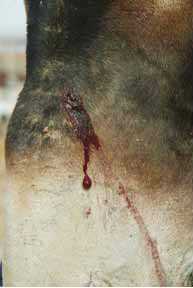Puncture Wound - Donkey
| This article has been peer reviewed but is awaiting expert review. If you would like to help with this, please see more information about expert reviewing. |
Definition: a puncture wound is a wound that has depth rather than size.


Puncture wounds in the skin and hoof etc., from sharp objects (e.g. nails, glass shards, bullets or other foreign bodies) are common and potentially very serious, although they are easily overlooked or trivialized. The size of the wound often belies the potential severity of the injury. The skin defect is usually trivial by comparison to the deeper damage. Even apparently minor wounds can be fatal if they involve synovial structures, the cranium or the body cavities. There is a high risk also from infection and anaerobes are particularly dangerous. The wounds may be difficult to explore effectively; this applies particularly to the sole of the foot. Infections of the interstitial tissues and the lymphatic vessels are termed cellulitis and lymphangitis respectively. In either case, infection can spread extensively from the site of the injury. This type of wound proves the ideal anaerobic environment for Clostridial organisms to flourish. Clostridium tetani is possibly the most dangerous of these.
Management of puncture wounds requires a detailed knowledge of the regional anatomy and some information on the cause and the direction of the penetration. Puncture wounds must be treated by scrupulous cleaning and, if necessary, widening of the injury to ensure full cleaning and avoidance of anaerobic conditions. Antibiotics and non-steroidal anti-inflammatory drugs are usually used. Controlled movement is usually considered to be an important aid to treatment. Tetanus prophylaxis is a major issue.
Healing of the skin wound is incidental in all cases.
References
- Knottenbelt, D. (2008) The principles and practice of wound mamagement In Svendsen, E.D., Duncan, J. and Hadrill, D. (2008) The Professional Handbook of the Donkey, 4th edition, Whittet Books, Chapter 9
|
|